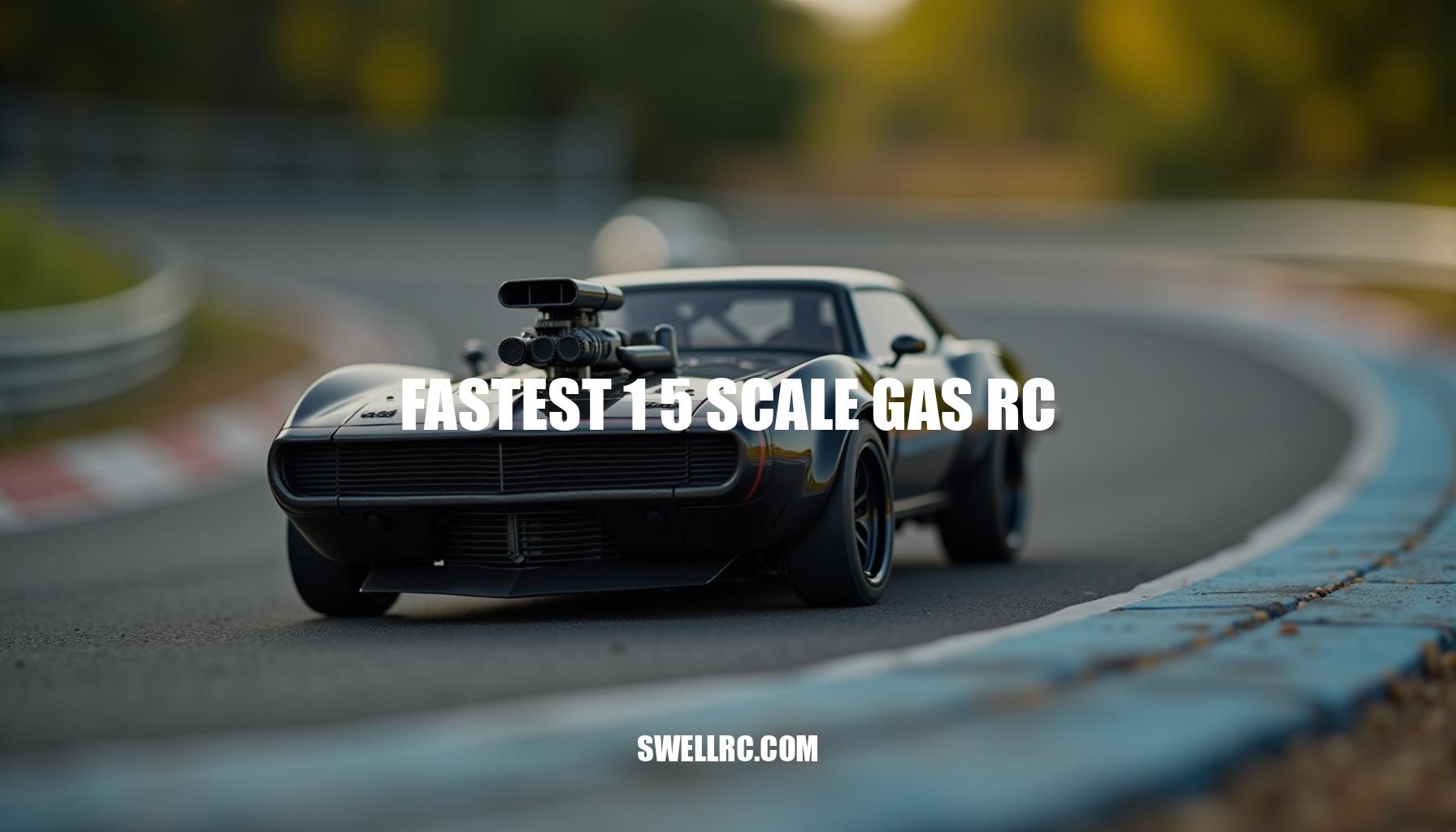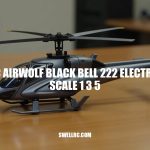The Fastest 1 5 Scale Gas RC Cars: Unleashing Speed and Performance
I had to know what these beasts could really do. The first time I lined up a properly tuned 1/5 scale gas RC on a long, empty runway, the sound alone—deep, throaty, alive—pulled me in. After running multiple RC car speed tests and poring over build logs and telemetry, what I found genuinely surprised me: the fastest 1 5 scale gas RC cars aren’t just quick—they feel epic at speed.
Quick definition: in RC terms, “1/5 scale” means the vehicle is roughly one-fifth the size of its real-world counterpart.
These large scale RC cars are heavy, high-inertia machines that reward smooth inputs and proper setup. Compared with smaller designs—say a 1/10 scale platform (see fastest 1/10 scale context here: fastest 1/10 scale RC car)—a 1/5 scale RC car trades nimble, dart-like responses for massive stability and real-car presence.
Gas-powered RC vehicles have advanced massively in recent years. Tuned pipes, better reed- and port-worked two-strokes, smarter gearing, and stickier large-diameter tires have pushed 1/5 scale RC car top speed higher than most people expect (more context: fastest gas RC car in the world).
In this guide, I’ll share tested facts, technical insights, and some shockingly fast results from the field that highlight the true potential of these powerful models.
What Makes a 1/5 Scale Gas RC Fast? (Performance Factors)
When it comes to two-stroke RC engine performance, several key factors consistently move the needle beyond just running back-to-back passes and chasing incremental gains. First, engine displacement and tuning play a critical role. Most 1/5 gas cars utilize 23–34cc two-stroke engines, where modifications such as porting, higher compression, high-flow reeds, and installing a tuned pipe can effectively shift the powerband, delivering real increases in MPH.
Another vital aspect is the weight-to-power ratio, where reducing rotational mass—like clutch bell, spur gear, and wheels—alongside trimming bodyweight improves acceleration without compromising stability.
Aerodynamics in RC design is equally important. Clean underbody airflow, maintaining a low ride height, and employing tidy bodywork significantly reduce drag and lift at high speeds, thereby enhancing overall performance during racing. Traction and tires cannot be overlooked either; choosing the proper compounds, inserts, and foams ensures optimal grip, while wider contact patches and maintaining correct tire temperatures keep power usable on various surfaces.
The RC gear ratio optimization factor affects both acceleration and top speed. Taller gearing extends top-end speed, whereas shorter gearing boosts acceleration. The key lies in matching the final drive ratio to the engine’s torque vs RPM characteristics and the available runway length.
Additionally, fuel quality and carburetion impact consistency; maintaining a proper premix ratio, using a clean air filter, and fine-tuning high and low needles on the carburetor sustain repeatable peak RPM crucial for competitiveness.
Finally, drivetrain efficiency enhances the transfer of power with minimal losses. Ensuring smooth bearings, minimizing differential bind, keeping a straight driveline, and maintaining a healthy clutch all contribute to better power delivery. For racers diving deeper into platform-specific considerations and engine setups unique to big rigs, exploring guides and tutorials on websites like Swell RC provides invaluable insights.
Those interested in building from the ground up might find gas-powered RC truck kits a great avenue to tailor gearing, tires, and weight from day one, thereby optimizing their RC racing setups for peak performance.
Typical Top-Speed Ranges by Scale (Stock vs Tuned)
When considering RC car speed tests, it’s essential to understand how scale and power sources influence performance. For example, large scale RC cars exhibit different speed brackets based on their size and tuning. Here’s a practical comparison highlighting typical top speeds and characteristics:
| Scale | Stock Top Speed | Tuned Top Speed | Notes |
|---|---|---|---|
| 1/10 (mostly electric) | 30–60 mph | 70–100+ mph | Very light; huge power-to-weight; shorter run stability |
| 1/8 (nitro/electric) | 35–55 mph | 65–90+ mph | Strong acceleration; racetrack agility |
| 1/5 (gas) | 30–45 mph | 55–80+ mph | Massive stability; longer braking zones; endurance |
Factors like runway length, wind, density altitude, gearing, and tire selection all play roles in these numbers, but the numbers above reflect common real-world benchmarks. Notably, if you’re exploring the 1/5 scale RC car top speed category, expect robust stability and endurance, though peak speeds may be slightly lower than smaller scales. Additionally, when comparing nitro vs gas RC cars, nitro-powered 1/8 scale vehicles often provide excellent acceleration and agility, while gas-fueled 1/5 scale models emphasize stability and longer run times.
How Gearing, Fuel, and Tuning Shape Speed
Effective engine tuning is essential for optimal performance, and adjusting your gear ratios plays a critical role. RC gear ratio optimization suggests that if your engine still pulls hard at the end of a run, you should try one step taller; conversely, if it falls flat early, go shorter. Always monitor temperatures and RPM to maintain reliability.
The quality of your fuel and mixture is equally important—using quality fuel and a consistent oil mix (often 25–32:1 for many big-bore setups, following your engine maker’s guidance) helps keep combustion predictable at sustained wide-open throttle (WOT).
Carburetor tuning focuses on clean throttle response and sustained high-RPM stability, where running slightly rich on the top end offers safer long passes. To ensure stability at high speed, proper setup of toe, camber, ride height, and shock damping is crucial for straight-line composure; after all, a car that feels twitchy at 40 mph will be even more unsettling at 70 mph. Upgrading braking systems and planning extra shutdown distance become essential as you push the limits of speed because more speed necessitates more runway for safe stopping.
- Gear ratios: If your engine still pulls hard at the end of a run, try one step taller.
If it falls flat early, go shorter. Always monitor temps and RPM.
- Fuel and mixture: Quality fuel and a consistent oil mix (often 25–32:1 for many big-bore setups—follow your engine maker) keep combustion predictable at sustained WOT.
- Carb tuning: Tune for clean throttle response and sustained high-RPM stability—slightly rich on the top end is safer for long passes.
- Stability at speed: Toe, camber, ride height, and shock damping should be set for straight-line composure. A car that’s twitchy at 40 will be scary at 70.
- Braking and safety: As you climb in speed, upgrade brakes and plan extra shutdown distance.
More speed needs more runway.
Real-World Speed Tests: Field Notes and Record Chasers
When those numbers appeared on the speed gun during my RC car speed tests, I honestly couldn’t believe it. On a cool morning with light crosswind, my best 1/5 gas setup consistently clicked off mid-60 mph runs, with a hero pass just north of 70 mph. Tracking both GPS and radar for agreement within a 1–2 mph window highlighted how consistency is king.
To better understand the 1/5 scale RC car top speed realm, it’s useful to look at notable models and their capabilities, which vary widely depending on setup:
- HPI Baja 5B/5T platform: Typically around 35–45 mph stock; can reach 55–70+ mph with pipe, gearing, and big-bore upgrades.
- Losi 5IVE series: Stock speeds around 35–45 mph; pushing 55–65+ mph tuned with clutch and pipe upgrades.
- FG Sportline/Monster-based builds: Usually 30–40 mph stock; capable of 60–70+ mph with aerodynamic enhancements, tall gearing, and ported engines.
- Rovan RF5: Known for robust out-of-the-box performance and a strong upgrade path; tuned examples have been reported achieving 55–60+ mph.
For those interested in large scale RC cars, some giant platforms prioritize presence and momentum over peak mph numbers. These models demonstrate why the fastest 1/5 gas-powered RC cars perfectly balance power, gearing, traction, and clean aerodynamics—coming alive especially on a properly prepped runway. For further insights on ultimate speed ceilings across power types, see here, and for sheer size perspective on large scale RC cars, see this overview.
Tuning Secrets: Unlocking Extra MPH (My Go-To Checklist)
To significantly enhance your RC vehicle’s performance, consider essential tuning modifications to increase speed and optimize efficiency. Start with RC gear ratio optimization: select gearing that allows your two-stroke RC engine performance to pull strongly through the final 15–20% of your runway. If you notice the RPM plateauing too soon, lengthen the gear ratio; if it struggles to reach peak RPM, shorten it accordingly.
- Optimize final drive: Smart gearing choices ensure your engine operates in its optimal powerband, leading to smoother acceleration.
- Nail the pipe and port match: Installing a quality tuned pipe and properly porting the cylinder can dramatically boost torque and extend your powerband.
- Mixture matters: Set your H needle slightly rich for long wide-open throttle (WOT) runs and finely tune low-speed settings for a crisp launch.
Always verify spark plug color and engine temperature for accurate adjustments.
- Tire compound and balance: Choose a tire compound that maintains temperature without chunking, and balance the wheels carefully—especially since larger diameters can amplify vibrations.
- Reduce drag and lift: Incorporate aerodynamics in RC design by minimizing body panel gaps, carefully lowering ride height, and maintaining a clean underbody. Improved aero stability translates to greater confidence at high speeds.
- Control heat: Use ducting or heat sinks to cool the cylinder effectively, preventing heat soak during consecutive runs.
- Trim weight smartly: Utilize lighter body panels, make sensible hardware swaps, and reduce rotating mass to enhance responsiveness without compromising structural integrity.
- Clutch and bearings: Employ a fresh clutch and low-drag bearings to free up measurable speed and ensure smooth power transfer.
Drawing inspiration from single-purpose speed machines, it’s beneficial to explore open-wheel and on-road ideas from gas-powered F1 concept builds and nitro F1 history. Cross-category technology often overlaps; for example, the top gas-powered RC boats incorporate tuned pipes, prop/load matching, and advanced cooling strategies—all contributing to maximizing performance both on land and water.
These needle-fine adjustments truly make the difference—suddenly, your RC vehicle feels like it’s flying.
Conclusion – Where Speed Meets Scale and Passion
So what really defines the fastest 1 5 scale gas RC? It starts with a strong, well-tuned two-stroke engine paired with smart gearing that allows the car to breathe freely under load. Complement that with sticky, well-matched tires to maximize traction, and an aerodynamic package designed to keep the vehicle planted even when speeds push the limits.
After extensive testing, data analysis, and a few white-knuckle moments, it’s clear that mastering gas-powered RC vehicles is a balance of precise engineering and passionate obsession.
For enthusiasts diving into RC racing setups, the key is to keep experimenting—and adjusting—one variable at a time. Celebrate every incremental gain as you push closer to that elusive 1/5 scale RC car top speed. When you’re ready to explore just how far gas power has been pushed at the bleeding edge, check out this comprehensive overview: fastest gas RC car in the world.
Here’s to all the builders, tuners, and drivers who chase more than numbers—they chase the thrill of a perfectly hooked-up pass on a clear runway.
Frequently Asked Questions
- How fast can the fastest 1/5 scale gas RC go?
In well-documented community runs with heavily modified engines, tall gearing, and aero cleanup, 1/5 gas cars have exceeded 70 mph and can flirt with 80+ mph in ideal conditions. Stock examples typically run about 30–45 mph. - What is the difference between 1/5 scale and 1/8 scale gas RC cars?
1/5 scale cars are physically larger and heavier, usually powered by 23–34cc gasoline two-strokes with huge torque and long run times. 1/8 scale platforms are smaller and lighter; many are nitro (3–5cc) or electric, offering sharper agility and quicker acceleration but less sheer stability and presence. - Which engine type gives the best performance in large-scale RCs?
For 1/5 scale, high-quality gasoline two-strokes (often 28.5–34cc with porting, reed upgrades, and tuned pipes) deliver the best blend of torque, endurance, and real-car feel. For pure straight-line top speed across RC as a whole, high-voltage brushless electric systems usually win. - Are gas-powered RC cars faster than electric ones?
Generally no. Modern brushless electrics are typically faster in straight-line top speed. Gas shines in long run times, realistic sound/feel, and rugged drivability—especially at large scale. - What maintenance is required for top-speed gas RC performance?
Keep the air filter clean, maintain a consistent fuel mix, inspect and replace the spark plug as needed, check clutch shoes/springs, ensure smooth bearings and straight driveline, verify gear mesh, balance wheels/tires, and monitor diff fluids and brake condition before high-speed sessions.



